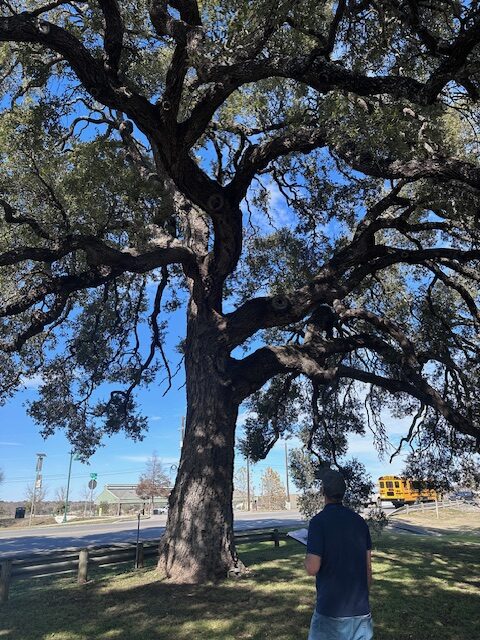Proper tree trimming in Central Texas is important for maintaining the health, safety, and beauty of your trees. While some basic tree care can be done by homeowners, making mistakes can lead to weak branches, disease, and even tree death. In Central Texas, where the climate is hot and diseases like oak wilt are a threat, knowing what not to do is just as important as knowing the right steps.
This guide covers common tree trimming mistakes to avoid, easy things you can do yourself, and when it’s best to call in a professional.
Tree Trimming Mistakes to Avoid
1. Trimming Oak Trees at the Wrong Time in Central Texas
One of the most critical mistakes homeowners make in Central Texas is trimming oak trees at the wrong time of year. Oak wilt, a deadly fungal disease, spreads through fresh wounds and is most active from April to July. Trimming during this time increases the risk of infection, which can quickly kill a tree.
✅ Best practice: Trim oaks only between August and February, when the disease is less active. If you must trim outside this window due to storm damage or safety concerns, seal the cuts immediately with pruning paint.
2. Over-Pruning or Topping Trees
Cutting too much at once can stress a tree, weaken its structure, and lead to poor regrowth. Some people top trees—cutting off the top branches to reduce height—but this causes unhealthy, weak growth and makes the tree more vulnerable to pests and disease. Additionally, when you remove more than 25% of a tree’s canopy, you are eliminating a significant portion of its food source. Trees rely on their leaves to photosynthesize and produce energy. Removing too much foliage can starve the tree, weaken its defenses, and in some cases, kill it.
✅ Best practice: Never remove more than 25% of a tree’s canopy in a single trimming session. Instead of topping, selectively thin out branches to maintain a natural shape.
✅ Best practice: Never remove more than 25% of a tree’s canopy in a single trimming session. Instead of topping, selectively thin out branches to maintain a natural shape.
3. Making Improper Cuts
Where and how you cut a branch impacts how well a tree heals. Cutting too close to the trunk (flush cuts) or leaving too much of the branch (stub cuts) can interfere with healing and invite disease.
✅ Best practice: Always cut just outside the branch collar—the slightly swollen area where the branch connects to the trunk. This helps the tree close the wound naturally.
4. Ignoring Disease and Pest Issues in Central Texas
Trimming diseased branches is necessary, but if you don’t clean your tools between cuts, you risk spreading infections. Central Texas trees are vulnerable to issues like oak wilt, hypoxylon canker, and insect infestations like borers.
✅ Best practice: Disinfect pruning tools with a bleach solution (1 part bleach to 9 parts water) or rubbing alcohol between each cut—especially when working on diseased trees.
5. Trimming in Extreme Heat or Drought
Summers in Central Texas can be brutal, and trees experience stress during extreme heat and drought. Trimming a live branch during these conditions can weaken a tree further, making it more susceptible to pests, disease, and sunscald.
✅ Best practice: Avoid trimming during severe droughts or high heat waves unless it’s for safety reasons or there are dead branches that could fall and cause property harm. If trimming is necessary, water the tree well before and after to help it recover.
Tree Trimming Tasks You Can Do Yourself
While major trimming should be left to professionals, homeowners can safely handle some basic tree care. Read the importance of keeping your trees trimmed.
1. Removing Small Dead Branches
Dead or broken branches under 2 inches in diameter can usually be trimmed with hand pruners or loppers. Removing these small branches improves tree health and reduces the risk of falling limbs.
2. Light Shaping of Young Trees
Newly planted trees need guidance to grow strong. You can lightly shape young trees by removing crossing or rubbing branches and keeping the main leader (central trunk) intact.
3. Cleaning Up Low-Hanging Branches
If branches are hanging too low over walkways, fences, or driveways, trimming them back can improve safety.
4. Mulching Around the Base
While not technically trimming, adding mulch around the base of your trees helps retain moisture, regulate soil temperature, and prevent lawn equipment from damaging the trunk. Keep mulch 2-4 inches deep and away from the trunk to prevent rot. Do not pile the mulch against the trunk like a volcano. It can suffocate your tree.
When to Call a Professional Tree Service
Some tree trimming jobs require experience, proper equipment, and safety precautions. Here are times when you should call a professional tree service instead of handling the job yourself.
1. Large or High Branches
If you need to remove branches larger than 3 inches in diameter or high up in a tree, it’s best to call a professional. Climbing and cutting without the right tools and safety gear can be extremely dangerous.
2. Trees Near Power Lines
If branches are close to power lines, never attempt to trim them yourself. This is a job for professionals trained in utility clearance.
3. Oak Wilt Concerns
If you suspect oak wilt or another tree disease, a certified arborist can properly diagnose the issue and recommend the best course of action.
4. Storm-Damaged Trees
Severe storms can cause split trunks, hanging limbs, or uprooted trees. A professional tree service can safely assess the damage and remove hazardous trees without causing further harm.
5. Large-Scale Tree Trimming
If your property has multiple trees needing maintenance, hiring a professional team ensures the job is done efficiently and correctly.
Why Choose a Certified Arborist for Tree Trimming?
Hiring a trained professional, like the team at Leaf Tree Services, ensures your trees get expert care tailored to Central Texas conditions. Our team follows industry best practices to promote healthy growth, prevent disease, and keep your property safe.
What We Offer:
- Expert Tree Trimming – Shaping, thinning, and deadwood removal for healthier trees.
- Oak Wilt Prevention – Safe pruning practices to protect oak trees.
- Safe Tree Removal – When a tree poses a risk, we remove it without damage to your property.
- Emergency Storm Cleanup – Rapid response for fallen or hazardous trees.
- Tree Risk Assessments – Identifying weak trees before they become dangerous.
Taking care of your trees properly means knowing when to trim, when to wait, and when to call in the pros. If you’re unsure about tree trimming on your property, we’re here to help.
📞 Call Leaf Tree Services today at 512-670-6766 for a free estimate or send us a message.
📍 Serving Round Rock, Georgetown, Austin, and surrounding Central Texas areas.
Your trees deserve the best care—let us help them thrive!


